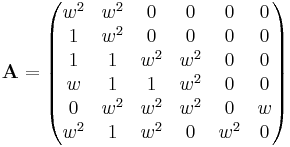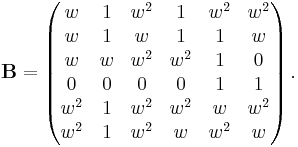Hall–Janko group
| Group theory |
|---|
| Group theory |
|
Cyclic group Zn
Symmetric group, Sn Dihedral group, Dn Alternating group An Mathieu groups M11, M12, M22, M23, M24 Conway groups Co1, Co2, Co3 Janko groups J1, J2, J3, J4 Fischer groups F22, F23, F24 Baby Monster group B Monster group M |
|
|
|
Solenoid (mathematics)
Circle group General linear group GL(n) Special linear group SL(n) Orthogonal group O(n) Special orthogonal group SO(n) Unitary group U(n) Special unitary group SU(n) Symplectic group Sp(n) Lorentz group Poincaré group Conformal group Diffeomorphism group Loop group Infinite-dimensional Lie groups O(∞) SU(∞) Sp(∞) |
In mathematics, the Hall-Janko group HJ, is a finite simple sporadic group of order 604800. It is also called the second Janko group J2, or the Hall-Janko-Wales group, since it was predicted by Janko and constructed by Hall and Wales. It is a subgroup of index two of the group of automorphisms of the Hall-Janko graph, leading to a permutation representation of degree 100.
It has a modular representation of dimension six over the field of four elements; if in characteristic two we have w2 + w + 1 = 0, then J2 is generated by the two matrices
and
These matrices satisfy the equations
J2 is thus a Hurwitz group, a finite homomorphic image of the (2,3,7) triangle group.
The matrix representation given above constitutes an embedding into Dickson's group G2(4). There are two conjugacy classes of HJ in G2(4), and they are equivalent under the automorphism on the field F4. Their intersection (the "real" subgroup) is simple of order 6048. G2(4) is in turn isomorphic to a subgroup of the Conway group Co1.
J2 is the only one of the 4 Janko groups that is a section of the Monster group; it is thus part of what Robert Griess calls the Happy Family. Since it is also found in the Conway group Co1, it is therefore part of the second generation of the Happy Family.
Griess relates [p. 123] how Marshall Hall, as editor of The Journal of Algebra, received a very short paper entitled "A simple group of order 604801." Yes, 604801 is prime.
J2 has 9 conjugacy classes of maximal subgroups. Some are here described in terms of action on the Hall-Janko graph.
- U3(3) order 6048 - one-point stabilizer, with orbits of 36 and 63
- Simple, containing 36 simple subgroups of order 168 and 63 involutions, all conjugate, each moving 80 points. A given involution is found in 12 168-subgroups, thus fixes them under conjugacy. Its centralizer has structure 4.S4, which contains 6 additional involutions.
- 3.PGL(2,9) order 2160 - has a subquotient A6
- 21+4:A5 order 1920 - centralizer of involution moving 80 points
- 22+4:(3 × S3) order 1152
- A4 × A5 order 720
- Containing 22 × A5 (order 240), centralizer of 3 involutions each moving 100 points
- A5 × D10 order 600
- PGL(2,7) order 336
- 52:D12 order 300
- A5 order 60
Janko predicted both J2 and J3 as simple groups having 21+4:A5 as a centralizer of an involution.
Number of elements of each order
The maximum order of any element is 15. As permutations, elements act on the 100 vertices of the Hall-Janko graph.
| Order | No. elements | Cycle structure and conjugacy |
|---|---|---|
| 1 = 1 | 1 = 1 | 1 class |
| 2 = 2 | 315 = 32 · 5 · 7 | 240, 1 class |
| 2520 = 23 · 32 · 5 · 7 | 250, 1 class | |
| 3 = 3 | 560 = 24 · 5 · 7 | 330, 1 class |
| 16800 = 25 · 3 · 52 · 7 | 332, 1 class | |
| 4 = 22 | 6300 = 22 · 32 · 52 · 7 | 26420, 1 class |
| 5 = 5 | 4032 = 26 · 32 · 7 | 520, 2 classes, power equivalent |
| 24192 = 27 · 33 · 7 | 520, 2 classes, power equivalent | |
| 6 = 2 · 3 | 25200 = 24 · 32 · 52 · 7 | 2436612, 1 class |
| 50400 = 25 · 32 · 52 · 7 | 22616, 1 class | |
| 7 = 7 | 86400 = 27 · 33 · 52 | 714, 1 class |
| 8 = 23 | 75600 = 24 · 33 · 52 · 7 | 2343810, 1 class |
| 10 = 2 · 5 | 60480 = 26 · 33 · 5 · 7 | 1010, 2 classes, power equivalent |
| 120960 = 27 · 33 · 5 · 7 | 54108, 2 classes, power equivalent | |
| 12 = 22 · 3 | 50400 = 25 · 32 · 52 · 7 | 324262126, 1 class |
| 15 = 3 · 5 | 80640 = 28 · 32 · 5 · 7 | 52156, 2 classes, power equivalent |
References
- Robert L. Griess, Jr., "Twelve Sporadic Groups", Springer-Verlag, 1998.
- Marshall Hall, Jr. and David Wales, "The Simple Group of Order 604,800", Journal of Algebra, 9 (1968), 417-450.
- Wales, David B., "The uniqueness of the simple group of order 604800 as a subgroup of SL(6,4)", Journal of Algebra 11 (1969), 455 - 460.
- Wales, David B., "Generators of the Hall-Janko group as a subgroup of G2(4)", Journal of Algebra 13 (1969), 513–516, doi:10.1016/0021-8693(69)90113-6, MR0251133, ISSN 0021-8693
- Z. Janko, Some new finite simple groups of finite order, 1969 Symposia Mathematica (INDAM, Rome, 1967/68), Vol. 1 pp. 25-64 Academic Press, London MR0244371
- Atlas of Finite Group Representations: J2


